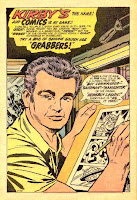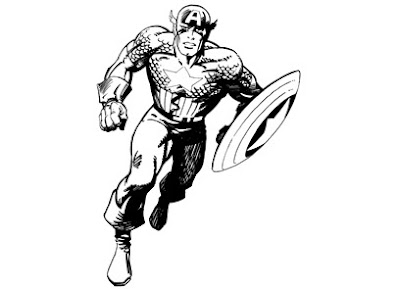
In the world of comic books, one man stands head-and-shoulders above all the rest and is truly deserving of his nickname, the King. That man is none other than Jack Kirby.
To be honest, in the late 1970s and early 1980s I found his art to be simplistic and stylized when compared to the more realistic work of John Byrne or Neal Adams. But as I began to branch out more and to understand the history of the industry I've come really come around.
From his modest beginnings growing up in New York's Bowery, Jacob Kurtzman used art as his "ticket out of the slums." As Jack Kirby, he either created or helped defined almost every major genre in the comic book field.
Much of his early work was done with writer Joe Simon. In 1941 they created the super-hero Captain America for Timely, which would later become Atlas and, ultimately, Marvel Comics. Over the next 15 years the two would go on to create and collaborate on Boy Commandos, a war comic, for National Comics (later DC); Stuntman and Boy Explorers for Harvey; crime stories in Real Clue; the teen comic My Date; the Romance genre for Crestwood/Prize Comics including Young Romance, Young Love, Western Love, Headline and Justice Traps the Guilty; a western called Boys' Ranch; and Fighting American, a super-hero parody for Crestwood.
When you figure in that both men served during WWII in the middle of this run, it's a pretty amazing, creative and productive run.
According to Been Publishing, I'm Back:
The next step was to become publishers themselves. In 1954, as the rest of the industry was retrenching due to the public furor over comics and juvenile delinquency, Simon and Kirby launched Mainline Comics, to minimal fanfare and mediocre sales. With titles like In Love, Foxhole, Police Trap and Bulls-Eye, they had all the popular genres covered. They were the most successful and well-known creators in comics history. And they failed miserably. Most titles lasted only four issues.
With the failure, the team split up to make each his own way in the new, post Comics Code, comic book landscape. Romance comics survived. Kirby did lots of strips for Harvey. (Simon and Kirby are listed as editors of some of the Prize/Crestwood romance books through 1957. Then it's just Simon - who also returned to drawing stories about 1960. Simon also went on to create Sick Magazine, a long-running Mad imitation.)
After the failure of Mainline, Kirby would continue to do work for other major publishers until 1959. Notable work from this period includes Challengers of the Unknown for National/DC and the newspaper strip Sky Masters of the Space Force, which was inked by Wally Wood for the first 8 months.
What came next is the stuff of legends. Kirby hooked up with Stan Lee at what was then Atlas, later Marvel, and started doing mystery, science-fiction, western and romance work. But the times were changing once again, and in 1961 with the advent of a new super-hero boom, Lee and Kirby were major players in kicking off what is generally called the Silver Age of Comics.
In short order, Lee and Kirby collaborated on creating The Fantastic Four, The Hulk, Iron-Man, Thor, The X-Men, The Avengers and brought back Captain America. Throughout the 1960's Kirby is now credited with playing a leading role in making Marvel a creative force. And while Kirby was responsible for developing the 'house style' he wasn't getting the credit he felt he deserved and was unable to share in the profits. So he chose to move on from Marvel and his partnership with Stan Lee to new, creative outlets.
Next was stint at DC where he created an epic 'Fourth World' consisting of New Gods, Forever People and Mister Miracle. While wildly creative, none lasted more than a few years and he moved on to Komandi, OMAC and The Demon before deciding to jump back to Marvel to create a Silver Surfer graphic novel in 1978.

During his last years he dabbled in Saturday morning cartoon shows and a couple of independent comics, but was generally happy to be be the "elder statesman" for the industry. And although I'll never get a chance to meet him, I'm sure I would have enjoyed sitting down with him and hearing one of his many stories about the war or his creative endeavors. Below you will find but a few examples of Jack's artistic prowess. Enjoy.
A small GALLERY of Jack Kirby Art pulled from the Internet
All art and copyrights are the property of their respective owners


























Next Up: Will Eisner
Cheers! - Jason



 It’s late fall, 1978 and Newt sits in a half-empty classroom on a dreary, stormy day. Half empty because Miss Jenny is out again with early morning sickness. And made doubly dreary as he and his fellow students are subjected to the grainy movie that is showing on the tattered sheet hung over the green, flaking chalk board.
It’s late fall, 1978 and Newt sits in a half-empty classroom on a dreary, stormy day. Half empty because Miss Jenny is out again with early morning sickness. And made doubly dreary as he and his fellow students are subjected to the grainy movie that is showing on the tattered sheet hung over the green, flaking chalk board.




 “You must keep your mind on the objective, not on the obstacle.
“You must keep your mind on the objective, not on the obstacle. “In suggesting gifts: Money is appropriate, and one size fits all.”
“In suggesting gifts: Money is appropriate, and one size fits all.”


 "Bush reiterated his stand to conservatives opposing his decision on stem cell research. He said today he believes life begins at conception and ends at execution."
"Bush reiterated his stand to conservatives opposing his decision on stem cell research. He said today he believes life begins at conception and ends at execution."

 a tip to his first name and his grand style of play. He broke into the bigs with the Cardinals in 1915 and amassed seven batting titles over 22 years playing for the St. Louis Cardinals (1915-1926, 1933), New York Giants (1927), Boston Braves (1928), Chicago Cubs (1929-1932), and St. Louis Browns (1933-1937). He topped the magic .400 batting average three times during his career. He was elected into the Baseball Hall of Fame in 1942, which also has this to say about him in his
a tip to his first name and his grand style of play. He broke into the bigs with the Cardinals in 1915 and amassed seven batting titles over 22 years playing for the St. Louis Cardinals (1915-1926, 1933), New York Giants (1927), Boston Braves (1928), Chicago Cubs (1929-1932), and St. Louis Browns (1933-1937). He topped the magic .400 batting average three times during his career. He was elected into the Baseball Hall of Fame in 1942, which also has this to say about him in his 
 “People ask me what I do in winter when there's no baseball. I'll tell you what I do. I stare out the window and wait for spring.”
“People ask me what I do in winter when there's no baseball. I'll tell you what I do. I stare out the window and wait for spring.” "I've always played hard. If that's rough and tough, I can't help it. I don't believe there's any such thing as a good loser. I wouldn't sit down and play a game of cards with you right now withing wanting to win. If I hadn't felt that way I wouldn't have got very far in baseball."
"I've always played hard. If that's rough and tough, I can't help it. I don't believe there's any such thing as a good loser. I wouldn't sit down and play a game of cards with you right now withing wanting to win. If I hadn't felt that way I wouldn't have got very far in baseball."



